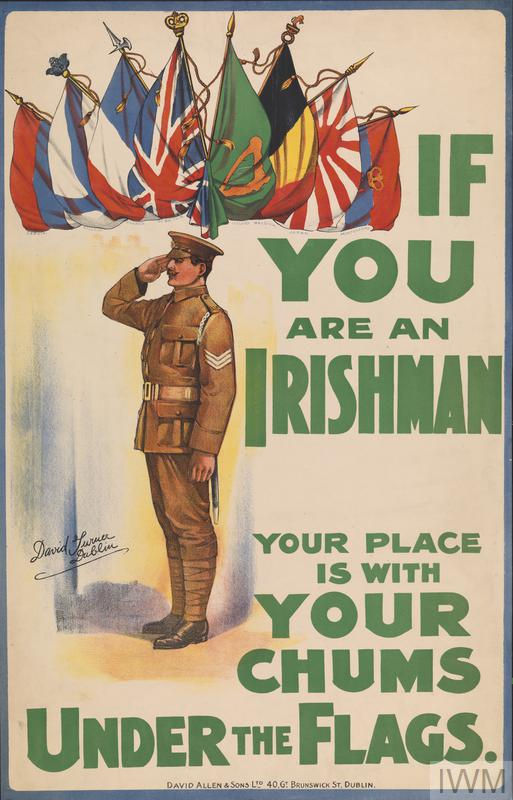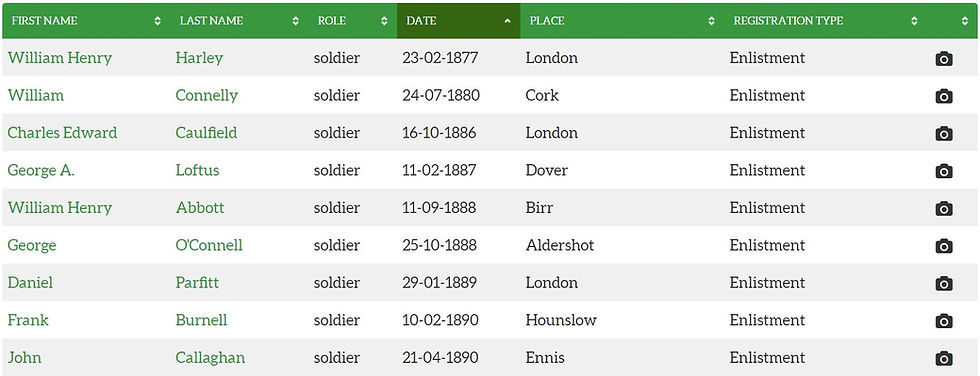Irish in the British Army : soldiers' records online and free at the National Army Museum
- Therese Lynch
- Nov 8, 2020
- 2 min read
Updated: Sep 26, 2022
Did you know you can search the enlistment books of the Irish regiments in the British Army that were disbanded in 1922 and also view the associated images? Better yet, access is online and free.

Above: An Irish recruitment poster. Copyright the Imperial War Museum
Ireland was a recruiting ground for the British Army and Navy for hundreds of years. However, when the Irish Free State was established in 1922, the five Irish regiments, then active in the British Army, were disbanded. They were the:
Connaught Rangers;
Leinster Regiment;
Royal Dublin Fusiliers;
Royal Irish Regiment;
Royal Munster Fusiliere.
Irishmen continued to enlist in the British military up to World War 2 and beyond as a means of employment and frequently as a means to support their families. However, there were no longer any homogeneous Irish regiments for them to join.
The enlistment books for the five regiments listed above have been digitized and are now held by the UK's National Army Museum. The Museum's website states the books contain soldiers' (but not officers') records serving in these regiments during the period 1920-22. When reviewing the database, I found records from as early as 1877 and as late as 1924. It appears not to matter when the soldiers enlisted. They were included provided they were still serving between 1920-22. Click here to search the records.

Above: sample search results showing the oldest records in the database.
An online search of the records initially returns an index list of records found. Clicking on the camera icon to the right of each line opens the record's image.
What information do the records hold?
These records hold a wealth of information about each person including:
Army Number;
Full name;
Date of attestation;
Age at attestation;
Place of attestation;
Transfer to or from regiment and date;
Trade on enlistment;
Period of mobilized or embodied service;
Place of birth - parish/town/county;
Full name and nationality of woman to whom married and name of each child; if unmarried name and address of Next of Kin stating relationship;
Place of marriage and birth of each child;
Date of marriage and birth of each child;
Campaigns, wounds, medals, or rewards of any kind;
Discharge or becoming ineffective:
Date,
Place,
Cause;
Rank and character on discharge;
Rate of Pension awarded (if any);
Address on discharge;
Particulars of former service giving Corps and number;
Remarks (which often include original regimental number).

Above: Search result showing the basic index information as well as the associated image to be viewed or downloaded. Courtesy of the National Army Museum
Conclusion
This is an unexpected and valuable resource for Irish family history research, particularly given approximately 60% of World War 1 soldiers’ Service Records were lost as a result of enemy bombing in 1940.
How did you go?
I hope you find these records as useful as I did. With Remembrance Day next week, it is timely that we search for our military ancestors. I found one of my Irish great uncles from Cork in the Leinster Regiment. I trust you will find success too. If so, I hope you will share your success in the comments box below.
Therese
Your Family Genealogist
Pictures: from the Imperial War Museum and the National Army Museum























Comments